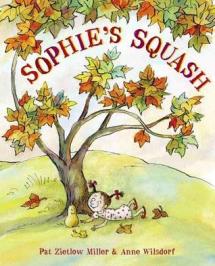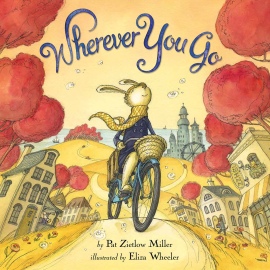Pat Zietlow Miller is the author of the award-winning (and adorable!) picture book Sophie's Squash, illustrated by Anne Wilsdorf. Sophie's Squash is story that celebrates the special love between a child and her favorite toy--only in this case it's a butternut squash. On a trip to the farmers' market with her parents, Sophie chooses a squash, but instead of letting her mom cook it, she names it Bernice. Sophie's Squash has earned many accolades and honors, including four starred reviews, the Golden Kite Award, the Charlotte Zolotow Honor Book Award, and the Ezra Jack Keats Honor Book Award.
 And fortunately for the children's book world, Pat has more books coming out in the world--SEVEN to be exact (at last count). Coming in April is Wherever You Go, illustrated by Eliza Wheeler. In Wherever You Go, join an adventurous rabbit and his animal friends as they journey over steep mountain peaks, through bustling cityscapes, and down long, winding roads to discover the magical worlds that await them just outside their doors. This book celebrates the possibilities that lie beyond the next bend in the road – the same road that will always lead you home again. Kirkus Reviews gave Wherever You Go a starred review with the praise: "Miller's verse, infused with musical momentum, communicates the emotional arch of a journey with beautiful brevity."
And fortunately for the children's book world, Pat has more books coming out in the world--SEVEN to be exact (at last count). Coming in April is Wherever You Go, illustrated by Eliza Wheeler. In Wherever You Go, join an adventurous rabbit and his animal friends as they journey over steep mountain peaks, through bustling cityscapes, and down long, winding roads to discover the magical worlds that await them just outside their doors. This book celebrates the possibilities that lie beyond the next bend in the road – the same road that will always lead you home again. Kirkus Reviews gave Wherever You Go a starred review with the praise: "Miller's verse, infused with musical momentum, communicates the emotional arch of a journey with beautiful brevity."
To learn more about Pat Zietlow Miller, visit her website.
Describe your workspace.
I write in one of two spots. At my kitchen table surrounded by the detritus of life in a family of four – books, papers, pens, calendars, mail, dishes – or at a desk upstairs that looks much more writerly. I’m probably in the kitchen more often just because that’s the way things seem to work out.
Describe a typical workday.
Most days, I’m at my regular job in corporate communications at an insurance company editing copy and writing about auto, home, and life insurance. (Hint: Having umbrella coverage is a good idea.)
When I get home, I start dinner, talk to my husband and kids, and help with homework where I can. English and language arts are fine. Calculus and physics are not. Then, when the kids are studying and my husband is watching basketball, I flip open my laptop and get going. Of course if the kids have evening activities, I’m probably driving them there instead of writing.
So when I do write, I tend to be pretty focused. I don’t have a lot of time to mess around.
List three of your most favorite things in your workspace and why they are meaningful.
These are all from my upstairs formal writing space.
- A dictionary and bookmark I got from my high school English teacher Gladys Veidemanis after I was voted “Most Likely to Be Published” by my classmates. It took more than 20 years after I graduated, but it did happen.
- A nameplate that belonged to my aunt, Faye Clow, who was director of the Bettendorf Public Library for many years. She was a huge proponent of books and literacy, and I always loved her and admired that. My upcoming book, Sophie's Seeds (Schwartz & Wade, 2016), is dedicated to Faye.
- The F&G [publishing term that means folded and gathered--they are fancy colored proofs] of whatever my next book is. Right now, I have Wherever You Go, which is coming from Little, Brown on April 21 and Sharing the Bread, which is coming from Schwartz & Wade on Aug. 25. Getting the F&Gs always makes the book finally seem real.
Do you have any rituals in your work habits? If so, describe them.
Open lap top. Sit down. Start typing.
Ignore any tears, arguments, or requests for help finding lost items until the young person involved either goes away or asks my husband. While some writers follow very organized processes when writing, I’m a little more haphazard. I wrote a post about this for Tara Lazar’s Picture Book Idea Month.
What do you listen to while you work?
Everything listed in my answer to the previous question. I really prefer not to have music playing while I write. It impedes my ability to focus on the story. (When you read my answer to the next-to-last question, you’ll see that this can be a problem.)
What is your drink and/or snack of choice while you’re working?
I normally don’t eat or drink while I’m writing. I tend to eat and drink when I get up and walk around because I’m temporarily stuck. Then, dark chocolate is always good. But I have standards. It’s got to be top-of-the-line stuff.
What keeps you focused while you’re working?
Getting the story done and making it the best it can possibly be. Finding the perfect combination of words is really important to me. And I love critique partners and editors who really challenge me if they think I haven’t quite done it.
Do you write longhand, on a computer, or another way?
Nearly always on a computer. Very rarely, I’ll write longhand if I’m on a plane or a bus and a pad of paper is all I’ve got to work with. But I do jot down notes longhand, usually phrases that I think sound intriguing.
How do you develop your story ideas? Do you use an outline, let the muse lead you, or another technique?
It sounds terribly boring, but I’m afraid I just sit down, open my laptop and start writing. Sometimes, I stare at my manuscript for a while before starting. While I certainly have been inspired, I don’t really believe in waiting for inspiration, because I could be waiting a long time. I find that the mere act of beginning to write usually kick-starts my inspiration.
If you were forced to share your workspace but could share it with anyone of your choosing, who would it be?
My husband. He’s a sportswriter and works out of our house. On days that I’m not at my day job, we often work in adjoining rooms. He’s fun to have around, although he sometimes plays really, really bad music while he works – like “My Girl Bill.” If we ever worked next to each other long term, this could become problematic.
What is the best piece of writing advice you’ve heard or received?
<!--[if gte mso 9]>
Normal 0 false false false EN-US JA X-NONE <![endif]-->
It’s what I learned in a high school journalism class taught by Ron Harrell. The end of your story has to have some element of the beginning in it to provide satisfying closure. He said it was like wrapping a ribbon around a present and tying a big bow. I wrote a blog post about this concept on Picture Book Builders.

 by Pat Zietlow Miller
by Pat Zietlow Miller
“What process do you follow to write your stories?” I’ve heard that question more frequently as I’ve sold more picture books, and I never know how to answer.
The people asking usually look as if they’re waiting for a golden ticket to inspiration. Like maybe I’ll say that I always walk three times around my living room, stand on one foot, hum the “Star-Spangled Banner” and then run to the computer to start writing before the muse I’ve conjured flies away. Then, they can do the same thing and wait for their own inspiration to strike.
When I tell the truth—that I don’t have a specific writing process—they seem disappointed. But, trust me. I’m doing them a favor. If they knew how things really go down, they might give up writing altogether. I’m a little haphazard.
But, just for you, in honor of PiBoWriMo, I am pulling back the curtain and sharing my process, such as it is. Here’s how I wrote WIDE-AWAKE BEAR, which is coming from HarperCollins in 2017:
Step One:
Have a cranky child.
Three years ago, my youngest daughter was happily napping on the couch. When I woke her to take her to volleyball practice, she had a world-class meltdown. There was wailing, tears and shouting. I tossed her into the car and took her anyway. Afterward, when she was calm, I said, “What was THAT all about?” Her response? “I was a hibernating bear. You woke me up, and I went into a bear frenzy.” (Author’s note: Is that not the best response ever? I love this kid.)
Step Two:
Forget about that adorable incident.
I filed that wonderful remark under the category of “Cool Stuff My Kid Has Said” and went about my business. For several years.
Step Three:
Be bored on a plane.
On a plane ride home from Yellowstone Park, where I was disappointed I hadn’t seen a bear, I thought I should use the flying time to do something productive. So I grabbed a notepad and pen and wrote a story about a bear cub who wakes up in the middle of winter and goes into a bear frenzy.
Step Four:
Listen to your critique group say, “Meh.”
I shared this story with my critique group and got a lukewarm response. They thought the bear cub got too cranky and deserved a timeout. They also didn’t understand why he got so angry. So I adjusted and reworked the story over several weeks. The title changed, and the storyline morphed into a bear cub who woke up midwinter, got scared and couldn’t fall back asleep. I shared it with some more writing friends and adjusted it even more. Then, I stopped, because I didn’t know what else to do.
Step Five:
Let it sit on your desktop for a while.
I wasn’t sure the story was ready. So I worked on other things and didn’t think much about it.
Step Six:
Send it to your agent on a whim.
Then one day, I opened the file and thought, “This isn’t so bad.” (See how I just glow with self-confidence?) I sent it to my agent, hoping she might give me a few ideas so I could work on it some more. But she thought it was ready to go, sent it out and it sold in about three weeks. That’s my quickest sale ever.
So, there you have it. How to write and sell a picture book in six simple steps. You know just what to do now, right?
I told another writer about my lack of a process, and she said, “You do have a process. It’s organic!” And she is absolutely right, because I’ve never once used pesticides in any of my books.
If there’s anything to learn from my post, it’s that everyone’s process is different. As long as you find something that works for you, you’ll be fine. If you’re not seeing the results you want and feel like your process may be fault, try a few different things.
- Be haphazard—I mean organic—like me.
- Be super-organized like another writer I know who sets her timer for 45-minute chunks and logs her writing time on a chart posted on her office door.
- Try writing mornings or evenings to see if something works better. Try different locations, too.
- Try standing on one foot in your living room and humming the national anthem. (It could work.)
Chances are something will seem more appealing to you and you’ll be well on your way to finding your own inspiration.

To learn more about me, visit PatZietlowMiller.com or follow me on Twitter at @PatZMiller.

If you leave a comment on this post you could be one of two people to win one of two prizes—a signed copy of SOPHIE’S SQUASH (Schwartz & Wade, 2013) to be sent immediately or a signed copy of WHEREVER YOU GO to be sent once it’s released from Little, Brown on May 5, 2015. Each of these books followed a totally different process than WIDE-AWAKE BEAR. I meant it when I said my process was haphazard.


This prize will be given away at the conclusion of PiBoIdMo. You are eligible for this prize if:
- You have registered for PiBoIdMo.
- You have commented ONCE ONLY on today’s post.
- You have completed the PiBoIdMo challenge. (You will have to sign the PiBoIdMo Pledge at the end of the event.)
Good luck, everyone!


I'm so excited that I finally have the cover for my fall book for Harcourt! It's probably my favorite of my covers so far - and it got me thinking about what makes a cover great.
What is it that makes you want to pull a book off a shelf, or a display and give it a try?
We buzz girls have been pretty lucky when it comes to cover art -- from Tina's sweet prom dress illustration to Marley's fierce Ghost Huntress photographic images -- the covers have really popped out at readers on the shelf. I know because I'm looking for them in every bookstore I go to!
I think the thing that is surprising is how little pull most authors have when it comes to covers for their books. Of course, it varies by publisher, but aside from a character sketch or vague idea I've shared with my editor, the art director is usually the one who is dreaming up the image and then sharing it with sales and marketing.
Before I sold a book, I would spend time sketching out ideas for my future covers - thinking that those might be useful someday. They were useful in one way - they kept my mind thinking that someday there would be a cover on my books. A self-fulfilling prophecy, in the end.
So, let's take an informal poll -- what is it that strikes you first about a cover?
1) The main image and how it relates to subject
2) The color combination
3) The title or cover blurb
4) The author's name
Are there any covers that you've really loved lately?
Hugs,
Heather
www.heatherdavisbooks.com
Wherever You Go - November 2011 Harcourt
The Clearing - HMH/Graphia
Never Cry Werewolf - HarperTeen
 And fortunately for the children's book world, Pat has more books coming out in the world--SEVEN to be exact (at last count). Coming in April is Wherever You Go, illustrated by Eliza Wheeler. In Wherever You Go, join an adventurous rabbit and his animal friends as they journey over steep mountain peaks, through bustling cityscapes, and down long, winding roads to discover the magical worlds that await them just outside their doors. This book celebrates the possibilities that lie beyond the next bend in the road – the same road that will always lead you home again. Kirkus Reviews gave Wherever You Go a starred review with the praise: "Miller's verse, infused with musical momentum, communicates the emotional arch of a journey with beautiful brevity."
And fortunately for the children's book world, Pat has more books coming out in the world--SEVEN to be exact (at last count). Coming in April is Wherever You Go, illustrated by Eliza Wheeler. In Wherever You Go, join an adventurous rabbit and his animal friends as they journey over steep mountain peaks, through bustling cityscapes, and down long, winding roads to discover the magical worlds that await them just outside their doors. This book celebrates the possibilities that lie beyond the next bend in the road – the same road that will always lead you home again. Kirkus Reviews gave Wherever You Go a starred review with the praise: "Miller's verse, infused with musical momentum, communicates the emotional arch of a journey with beautiful brevity."





 by
by 




Love her simple approach! I’m in a “frenzy” about it! 😃
The message I keep hearing is collect all those life snipetts because you never know were they might lead you. Thanks!
Pat, your post is entertaining. Just like your books.
My process is similar, except for having the agent to send it to.
Dear Pat, Thank you for some valuable insight. One of my takeaways is :in spite of the critiques- go with your gut. Thanks for that and more!
Dear Pat,
Your article of a glimpse into your writing personality for Tara & us is totally not “meh.” I have long luvved that word because it makes me work harder.
I think the push-me, pull-me directions here are the bear’s bacon. Brava!
And very un-meh kudos for your picrure books!
j a n
Jan Godown Annino
@BkSeedStudio
Thank you, Pat! Your posting helps me believe in myself.
You have to believe.
Thank you Pat, Whats the title of your bear book, id love to read it!
I love your sense of humor Pat! Your process may be organic, but your eye and ear for the sublimely wonderful and funny are also spot-on!